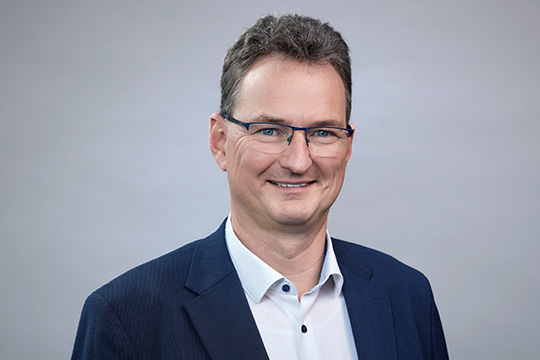Connectivity offers the opportunity to build completely new business models. This leads us more and more towards the factory of the future. Falk Schröder, Managing Partner at Detecon International GmbH, takes us on a journey to the possibilities of today and tomorrow in a joint interview.
Detecon: The requirement for connectivity is now appearing everywhere. What exactly are we talking about here?
Falk Schröder: First of all, ensuring connectivity means nothing more than ensuring that the connection is maintained. There are different technologies for this: 2G could only transmit voice, with 3G came data transmission. Only LTE then guaranteed unproblematic and fast data transmission.
Today's requirements call for even higher data volumes as well as quality requirements, since machines communicate with each other and make decisions via a network. If artificial intelligence or machine learning comes into play, interactive connectivity is created. 5G promises to unify all these network requirements on one network and to optimize them individually and purposefully depending on the application.
Based on connectivity, information of the most varied kinds is thus brought together, linked and evaluated in order to be able to make decisions. In this way, the autonomously driving vehicle communicates with other vehicles and receives information on speed changes as well as information from the camera transmission that the vehicle carries with it. The combination of all this information creates a data base on which the vehicle can make decisions in order to reach its destination safely.
5G thus covers many different requirements on one network. But does it always have to be 5G or are other technologies sufficient?
Connectivity does not mean 5G. Whether 5G is required depends entirely on the application and the requirements to be derived from it.
When selecting the appropriate connectivity solution, the aim is not to use the latest technology, but to select the technology that is sufficient to meet the respective individual requirements and needs. This requires understanding and considering the impact of each requirement and matching it to the technology.
5G, unlike other technologies, offers collaboration with SIM cards. This has the advantage that only components equipped with a SIM card alone can access the system. This ensures that not everyone can access the system, as is the case with Wi-Fi. However, even with 5G, avoiding overloading the system is not completely guaranteed.
Further differences are for example in the mobility requirements. Ultimately, the underlying use case and the future direction decides on the system to be used.
When is a 5G network useful?
In a 5G network, millions of services and things can be simultaneously networked and securely transmitted. The added value of converting to a 5G network is always justified when many different processes are only permitted with this new technology. As part of a proof of concept, the added value of a 5G network is examined to decide whether the network upgrade is useful or whether a Wi-Fi 6 network is sufficient. If the basic technology is to be changed, one must be able to rely on the fact that a smooth process is ensured. It would be an impossible situation if a 5G network were to suddenly stop operating for three days. That is why the backup of data volumes is a particularly important requirement. To ensure that information is delivered extremely promptly, a certain latency must not be exceeded. How much latency a company needs for the realization of its processes can be calculated by means of extrapolations based on the use cases. We offer the 5G Health Check to determine the required bandwidth.
In the context of the 5G discussion, the keyword campus network always comes up. What exactly is that?
A campus network is ultimately nothing more than a network in a secure environment. It is located on a private site and is not subject to the regulatory requirements of the state. Since most companies are very sceptical about mobile phone providers and do not want to depend on them, more and more local 5G-based networks are being dedicated to campus owners. The "industry solution" in Germany offers you the option of applying for your own frequencies or building them yourself to avoid dependency.
Connectivity solutions live above all through partnerships. In your opinion, which partnerships make sense in order to establish connectivity optimally in the company?
First, the basis for connectivity must be established in a specific area. The network can be built by the company itself or provided by a provider. Next, a connection to a locally available cloud system is required, which is called "edge" in mobile communications. A cloud is nothing more than a large, empty data center that has to meet certain requirements such as speed, certain test set times and others. This cloud system is often provided by a partner. In order for this data center to be filled, the application vendors are required as additional partners who place their application on this environment for use. Everything together must work end-to-end. Since the many requirements are offered by many different partners, a partner concept and thus an ecosystem is established here. However, partnership here means that you are a partial supplier. For an ecosystem to function properly, the focus is on the overall well being with individual benefits. Furthermore, it is important that the ecosystem is an advantage for all partnerships. This requires a special trust that we first have to learn and which has to be built up, and which is ultimately contractually secured.
Could there also be capacity constraints? What are the current limits of connectivity?
In theory, the limits are very flexible, but in practice it's up to the investment. So it depends on the utilization of the requirements. The 5G network naturally offers the advantage that several applications can be provided in the same network.
Capacity limitations can occur, especially with cloud systems. A small cloud system only has limited capacity, so only a limited number of services can fit on the system. However, even if the capacity of one system is full, it is still possible to run one or more cloud systems in parallel. This extends the capacity.
It becomes problematic if a hall is only dimly lit via antennas, but the requirements and thus the need for more latency have increased. To achieve a higher bandwidth, each antenna would have to be supplied with an FFTH connection, thus creating a driver network. If this is to be installed on a campus where production is already underway, special cable routing is required. This can lead to additional work and thus to higher costs.
For this reason it is always advantageous to plan and act in a visionary way. Again, the desired and possibly hoped-for use cases must be taken into account.
Keyword "factory of the future". In your opinion paper of the same name, you criticize the fact that the areas of information technology (IT), operational technology (OP) and engineering technology still often operate as silos today. To what extent do the three areas contribute to increased productivity once they are connected?
IT acts as the backend of every company and provides classic IT connections, often LAN- or WAN-based, to ensure the connection of servers. The operative technology supports the operational processes within an organisation, i.e. optimises processes with the help of the appropriate technology.
Today, many machine parks are equipped with Wi-Fi so that the machines communicate via the Wi-Fi standard. The two areas - information technology (IT) and operational technology (OT) - therefore merge into one another here.
Engineering technology develops dedicated new services to build a product.
The following example can help to provide a better understanding:
A car door communicates with a machine via radio (IT). A chip is implemented in the vehicle door, which carries information about the door's paint processing. For example, the surface is to receive a different paint colour than the handle. In the communication between chip and machine, the machine takes up this request, prepares the painting process accordingly and paints the vehicle door (OP). The engineering technology is responsible for developing a new spraying process for the painting process.
In the factory of the future, the aim is to actually implement such a process. As soon as the three areas - Information Technology, Operational Technology and Engineering Technology - are linked together, completely new efficient processes will be possible.
To which industries does the "factory of the future" apply?
Behind the keyword "Factory of the Future" lies the conversion and construction of systems. This applies in particular to the manufacturing sector, but also to the logistics sector, for example. These industries come together with different services at airports and seaports. They have individual requirements that make a connectivity solution necessary to meet them flexibly and adaptively. An example: An airport is building a 5G network. An airline based at the airport wants to use it and announces that it wants to use 5G to download data after each flight. Today, the download of data, which includes terrabytes, is partly downloaded using a thick cable that is manually connected to the aircraft by a skilled worker. Often the download takes a long time, so that valuable time is lost, for example, because loading and unloading is already completed during this time. A fast download in the travel time between landing and docking at the finger over 5G and the availability of the service on a local cloud behind it would therefore save time and therefore money. The connectivity can then be provided like a VPN on the 5G network, the service is available on an underlying local cloud.
Are there any pioneers who have already implemented this form of "factory of the future"?
In China there are the first airports that are fully equipped with 5G. The passenger is offered direct communication via an installed app and a button in the ear. If the passenger gets lost, the airport whispers in his ear in which direction he has to walk in order to be at the check-in on time. Other services would include, for example, directions to a specific product at the airport or the identification of suitcases via the app. However, the passenger must have agreed at check-in that the airport may use their biometric data to observe the passenger via the cameras.
Germany is beginning to implement this, but is still in a very early phase.
Mr. Schröder, many thanks for the informative interview!







